#but Raj is slowly converting him
Explore tagged Tumblr posts
Text

Day 6: Watching Big Time Movie for the umpteenth time
Starring
Raj as the guy who pauses every five minutes
and
Bowie as the guy who fawns over the costumes
#rajbow week#rajbow week 2023#rajbow week day 6#pinheadbellart#rajbow#total drama raj#total drama bowie#total drama#total drama island reboot#total drama island spoilers#big time rush#big time movie#I was stumped on what movie they should be watching#and then I remembered Big Time Rush had a movie#so I watched the trailer for reference#and yes that is Carlos Pena dressed as a secret agent with a bear behind him#I think they’re in a car? like a jeep?#point is Raj is gonna infodump about BTR lore any chance he gets#and I like to think Bowie isn’t that big of a boy band fan#but Raj is slowly converting him#and Bowie realizes boy band boys can be cute dorks like his bf
29 notes
·
View notes
Text
Kasam Serial


To watch the full episode of ‘Kasam’ anytime, Download the Voot app now or Visit https://www.voot.com/shows/kasam/1/380386/the-conflict-takes-a-new-turn-/537. Colors TV’s Kasam Tere Pyaar Ki is one of the most loved shows on the channel. The sizzling chemistry of Tanuja and Rishi has been appreciated the viewers and since the separation track, the show has managed to maintain its rating. However, the rumours of Kasam Tere Pyaar Ki is still making rounds. Kasam was best serial i will always remeber,hope krasha together come onscreen. Arpu 28th Jul 2018 - 10:49 am. Kasam is ended.with 3 birth. Kasam Written Updates Read Written Episodes. Colors TV Hindi Serial Kasam ended on 27th July 2018.
Kasam — Tere Pyaar KiAlso known asKasamGenreFiction Drama RomanceDirected byMujammil DesaiStarringKratika Sengar Sharad MalhotraCountry of originIndiaOriginal languageHindiNo. of seasons1No. of episodes623ProductionProducersEkta Kapoor Shobha KapoorCamera setupMulti-cameraRunning time21-25minutesProduction companyBalaji TelefilmsReleaseOriginal networkColors TV Rishtey EuropePicture format576i (PAL) HDTV1080iOriginal release7 March 2016 – 27 July 2018External linksOfficial website
Kasam Tere Pyaar Ki (Swear by your love) is an IndianHindiromantic television series that aired from 7 March 2016 to 27 July 2018 on Colors TV.(1)Kratika Sengar and Sharad Malhotra played the lead roles in a saga of lovers reuniting after rebirths.(2) The show has been dubbed in Bengali in Colors Bangla as 'Shopoth Bhalobasar' and has been aired since 9 February at 9.30pm.
Plot(edit)
Tanushree 'Tanu' Khurana and Rishi Singh Bedi are childhood friends living in Patiala, just like their respective fathers Veerendra and Raj. Katyani Bai, a Kali devotee and priestess prophesies that Rishi and Tanu will be together for their next seven births. They are separated after Rishi's mother Rano, who dislikes Tanu, forces Raj to move to America with their entire family.
Time.is automatically displays the time in your time zone by using your IP address to detect your location. Your IP address is 40.77.167.21. Your detected location is New. Current UTC — Coordinated Universal Time. 7 AM ( 7:00 ) Universal Time to Your Local Time and Worldwide Time Conversions. Universal Time: 7:00 AM (7:00) GMT ( UTC ): 7:00 AM Local Time to Universal Time. 7:00 AM (7:00) Universal Time: GMT ( UTC ): » Universal Time to Local Time Main Conversion Page. Scale:. Is local time not Right? Input the time zone below to convert: » UTC. 7 PM ( 19:00 ) Universal Time to Your Local Time and Worldwide Time Conversions. Time difference between your local time and UTC is: -7 hour (s) (-420 minutes). latin ante meridiem, meaning before midday, PM or P.M. latin post meridiem, meaning after midday. Letter 'Z' in military time indicates ZULU Time Zone which is equivalent to UTC.
17 years later(edit)
Tanu desperately waits to reunite with Rishi who returns to India. Veerendra and his wife Sharda are killed in a terrorist attack. Tanu's aunt Bani lies to Rishi's family that her own daughter Neha is Tanu. His alliance is fixed with Neha while Tanu gets engaged to the Jalandhar-based Pawan Malhotra.
Rishi slowly develops a soft corner for Tanu. After many circumstances, he learns about Tanu's identity. She realises her love for Rishi and they marry. To save him from being shot to death by Neha's boyfriend Sandeep, Tanu sacrifices herself and dies sadly. Her spirit appears in front of a shattered Rishi and tells him that she will return for him.
20 years later(edit)
Tanu reincarnates as Sandy's niece Tanuja Sikand and lives in a village near Amritsar. Rishi is now heartless and has lost his faith in love, having turned into a successful business tycoon. His grandmother Preeti develops a bond with Tanuja. Tanu's sister Ahana has married Rishi's brother Manpreet, and they have two children. Sandy reveals to Tanuja that he shot Tanu to death.
Fire breaks out because of a short circuit and Rishi and Tanuja are injured. Tanuja's face is badly burnt in the accident while saving Rishi. Xampp and wamp. Preeti mistakenly gives Tanu's photo to the doctor for plastic surgery. Tanuja gets Tanu's face, and comes to know about the same. She is shocked.
Rishi accuses Tanuja of purposely changing her face, and throws her out of the Bedi house. Rishi's friend Malaika arrives from America. He agrees to marry her. As Raj sees Malaika with her boyfriend Shekhar on wedding day, he asks Tanuja to become Rishi's bride and they marry.
It was Shekhar and Malaika's plan to ruin Rishi's company because he was Rishi's business rival. Closeness increases between Rishi and Tanuja. Gradually, Rishi starts to fall for Tanuja when their misunderstanding is cleared. Malaika is exposed, and thrown out of the house. Rishi and Tanuja consummate their marriage.
After some other twists, Katyani tells Tanuja that she is unlucky for Rishi. Tanuja demands divorce from Rishi thinking she is unlucky for him; both sign divorce papers. His half-brother Poorab Bohra demands 51% of the shares of his company to exact revenge on Raj. Knowing Poorab's intentions, Tanuja arranges for the property to be signed over to her with the help of Raj and Preeti.
Rishi gets engaged for marriage to Rano's friend's daughter Netra, to make Tanuja jealous. As he forces, she signs the property over to the Bedis. Tanuja leaves. Rishi goes to stop her at the railway station, but as she declines to return, he slaps her in anger during the argument and she finally sits in the train before realising she is pregnant with his child.
7 years later(edit)
https://blogsmith57.tumblr.com/post/655262564465442816/acronis-2013. Tanuja lives with her daughter Natasha and friend Abhishek Khurana, a businessman in London who pretends to be her husband and Natasha's father. Rishi and Netra also pretend to be married and have been raising Tanya, the daughter of Ahana and Manpreet's daughter Smiley. Natasha and Tanya assume Abhishek and Rishi to be their respective fathers.
Abhishek reaches India with Tanuja and Natasha to take over Rishi's company. Rishi meets Natasha at the airport, unaware that she is his daughter, and develops a special bond with Natasha who enrols in Tanya's school. Abhishek and Rishi become business partners. Abhishek invites Rishi, Netra and Tanya to dinner where Rishi meets Tanuja.
Rishi is disheartened to learn that Tanuja is Abhishek's wife (in real fake) and has a daughter, and tries to get her back in his life. He tries to make Tanuja remember their past. Netra discovers that Tanuja is just Abhishek's caretaker and friend not wife. She reads Natasha's birth certificate and learns that Rishi is her biological father.
Rishi, after seeing Abhishek's love for Natasha, decides to leave Tanuja's life. Rishi finally learns that Natasha is his daughter indeed. He informs his family that he is Natasha's father. Abhishek, who has fallen in love with Tanuja, learns of her past with Rishi. Rano sends a legal notice for Natasha's custody.
During the custody case, Rishi learns that Tanuja is Abhishek's caretaker. Abhishek proposes Tanuja who earlier refuses but later insists that he marry her to obtain Natasha's custody. Rishi creates problems in the wedding. He decides to marry Netra to obtain Natasha's custody. Tanuja learns that Rishi and Netra aren't married and assumes that they instead have a live-in relationship.
Realising his love for Tanuja, Rishi leaves Netra and stops Tanuja's marriage, reasoning that their divorce application was rejected years ago. Abhishek accuses Tanuja of cheating on him. Tanuja reveals to Natasha that Rishi is her father. Natasha tells court judge that she wants to live with both her parents.
Tanuja is ordered to stay in the Bedi house for six months. Netra now vows to ruin Tanuja. Abhishek creates misunderstandings between Rishi and Tanuja to separate them. After many circumstances, Tanuja realizes her mistake as Rishi tells her the truth, and apologises to him. They reconcile. Jealous, Netra vows to kill Rishi and Tanuja.
Netra bribes a mechanic to tamper with the car brakes in which Rishi and Tanuja are. Abhishek finds her plan but is late to warn Tanuja. The car falls off a cliff and Abhishek takes them to the hospital. Netra is arrested. Tanuja dies in the hospital. Depressed, having lost Tanuja after Tanu, heartbroken Rishi kills himself with poison.
25 years later(edit)

Rishi and Tanuja are reborn as Ranbir Kapoor and Kritika Kohli, respectively. Ranbir is a famous football player in (Canada) and Kritika lives with her mother Malini near (Ludhiana). Ranbir has blurry flashbacks of his past birth in his dreams.
Believing that her husband Arun died, Malini is shocked to see him on news and reaches Mumbai with Kritika to track him down. Ranbir also arrives in Mumbai with his family for a football match.
While Malini searches for Arun at a mall, a fire breaks out, with Kritika and Ranbir there. Kritika exits safely and Ranbir stays inside to help Malini, who is rushed to hospital.
Hospitalised, Malini tells her that Arun is alive and gives his address to Kritika and dies. Kritika learns that her father, Arun has married again to Parminder a.k.a. Pammi and has two daughters, Jiana and Ishani. Arun tells Pammi that Kritika is his niece as she enters the house and lives with them.
Later, Kritika meets Ranbir for first time and they have argument. When she is appointed as intern of an advocate Vikas Sharma. Ranbir's father Balraj becomes involved in a legal battle over custody of his mansion with its caretaker Aayush Batra. Vikas is Ayush Batra's lawyer.
Kritika is harassed by a local contractor Ashok but Ranbir saves her. Jiana (Kritika's half-sister) and Akshay (Ranbir's cousin) fall in love. Ranbir develops feelings for Kritika and they become friends.
Aayush's daughter Malishka drugs and tries to seduce Ranbir. As he rejects her, she frames him for molesting her and files a case. Ranbir is arrested by police but Akshay bails him out.
Eventually, Ranbir wins the case with Kritika's help. Malishka tries to kill his family by burning down the house. Ranbir expresses his love to Kritika but gets unconscious after a pillar falls.
Kritika recalls her previous lives and awakens Ranbir to remind him, who also recognises her and they hug each other and unite, ending the series.
Cast(edit)
Main(edit)
Sharad Malhotra as
Rishi Singh Raj Singh Bedi (2016–18)
Ranbir Balraj Kapoor(Rishi's reincarnation) (2018)
Kratika Sengar as
Tanushree Rishi Singh Bedi (Tanu)(nee' Khurana) (2016)
Tanuja Sikand / Tanuja Rishi Singh Bedi (after plastic surgery)(Tanushree's reincarnation) (2016–18)(3)
Kritika Kohli (2018)(Tanuja's reincarnation)
Shivani Tomar as Tanuja Sikand (2016) (before plastic surgery)
Recurring(edit)
Saba Mirza as Preeti Prem Singh Bedi (Beeji) (2016–18)
Vijay Kashyap as Raj Singh Prem Singh Bedi(Preeti's son,Rano's husband,Yuvraj,Manpreet,Rishi's father) (2016–18)
Vibha Chibber as Rano Singh Raj Singh Bedi(Raj's wife,Rishi,Manpreet,Yuvraj's mother ) (2016–18)
Lalit Bisht as Yuvraaj Singh Raj Singh Bedi(Raj and Rano's adopted son,Divya's husband,Nakul's father ) (2016–17)
Chetna Kaintura as Divya Yuvraaj Singh Bedi(nee' Malhotra)(Yuvraj's wife,Nakul's mother) (2016–17)
Zuber K. Khan as Manpreet Singh Raj Singh Bedi(Yuvraj and Rishi's younger brother,Ahana's husband,Smiley and Chintu's father) (2016–18)
Aditi Sharma Ved as Ahana Manpreet Singh Bedi(nee' Khurana)(Manpreet's wife,Tanushree's younger sister,Smiley and Chintu's mother) (2016–18)
Manorama Bhattishyam as Katyani Bai(Future predictor) (2016–17)
Nikhil Khurana/Pranav Misshra/Pratyaksha Rajbhatt as Nakul Singh Yuvraj Singh Bedi (2016–17)(Yuvraj and Divya's son)
Farhad Khan/Chandni Sandhu as Smiley Singh Manpreet Singh Bedi (2016–17)
Devarsh Nirmal as Chintu Singh Manpreet Singh Bedi (2016)
Pratik Parihar as Rohitesh(Smiley 's boyfriend,Tanya's real father) (2016)
Roma Bali as Bani Kuljeet Khurrana(Tanushree's aunt,Kuljeet's wife,Neha and Swati's mother) (2016–17)
Gagan Gupta as Kuljeet Khurrana (2016)(Veerendra's younger brother Tanushree's uncle,Bani's husband,Neha and Swati's father)
Arun Singh Rana/Sharhaan Singh as Sandeep Sikand (Sandy)(Neha's husband) (2016
Renee Dhyani as Neha Sandeep Sikand(nee' Khurana)(Kuljeet and Bani's elder daughter,Tanushree's cousin,Sandeep's wife) (2016–17)
Suman Jain as Swati Kuljeet Khurrana(Kuljeet and Bani's younger daughter,Tanushree's younger cousin Neha's younger sister) (2016)
Hema Sood as Nidhi Sandeep Sikand (2016)(Sandeep and Neha's daughter)
Shreya Gupta as Vidhi Sandeep Sikand (2016–17)(Sandeep and Neha's daughter)
Vishnu Sharma as Veerendra Khurana(Tanushree's father,Sharda's wife) (2016)
Jyoti Gauba as Sharda Veerendra Khurrana(Veerendra's wife,Tanushree's mother) (2016)
Malhar Pandya as Pawan Malhotra(Saloni's husband Tanushree's ex-fiance) (2016)
Sehrish Ali as Saloni Pawan Malhotra(nee' Shah)(Pawan's wife) (2016)
Parveen Kaur as Savitri Vyom Malhotra(Pawan's mother) (2016)
Smriti Khanna as Malaika Malhotra (2016–17)
Rohit Sharma as Shekhar Singh Ahlawat(Rishi's business rival,Malaika's boyfriend) (2016–17)
Abhilash Kumar as Rohit Prakashan (2016–17)(Abhishek's friend)
Pranitaa Pandit as Netra Mehta (2017–18)
Amit Tandon as Abhishek Khurana(Tanuja's ex-fiance,Natasha's foster father) (2017–18)
Shivika Singh as Natasha Singh Rishi Singh Bedi(Rishi and Tanuja's daughter) (2017–18)
Chahat Tewani as Tanya Singh Bedi(Rishi and Tanuja's foster daughter,Rohit and Smiley's real daughter) (2017–18),
Puneet Sachdeva as Poorab Singh Bedi / Poorab Vohra (2017)
Shraddha Arya as Swati Poorab Singh Bedi (cameo) (2017)
Aishwarya Raj Bhakuni as Riya Jakhar(Abhishek's secretary) (cameo) (2017)
Sonali Joshi as Abhishek's aunt
Rini Das as Myra Khurana (2017-18)
Aansh Arora as Samar Singh Rajput (2017)(Abhishek's friend)
Mayank Kumar as Rohit(Abhishek's friend) (2017-2018)
Rajesh Puri as Arun Kohli (2018)(Kritika's,Jiana,Ishani's father,Malini's husband)
Jyothi Joshi as Malini Arun Kohli(Arun's first wife,Kritika's mother) (2018)
Shivani Gosain as Parminder Arun Kohli (Pammi)(Arun's second wife,Kritika's stepmother,Jiana and Ishani's mother) (2018)
Vedika Bhandari as Ishaani Arun Kohli(Arun and Pammi's daughter,Kritika's younger stepsister,Jiyana's elder sister) (2018)
Sabina Jat as Jiyana Arun Kohli(Arun and Pammi's younger daughter,Kritika's youngest stepsis ter,Ishani's younger sister) (2018)
Bikramjeet Kanwarpal as Balraj Kapoor(Ranbir's father,Mahima's husband,Akshay's uncle) (2018)
Manjushree Kulkarni as Mahima Balraj Kapoor(Balraj's wife,Ranbir's mother,Akshay's aunt) (2018)
Karan Goddwani as Akshay Kapoor (Akki)(Balraj and Mahima's nephew,Ranbir's younger cousin) (2018)
Shamin Mannan as Malishka Ayush Batra (2018)
Amit Behl as Aayush Batra (2018)
Jiten Lalwani as Advocate Vikaas Sharma (2018)
Pooja Singh as Malishka's cousin Shilpa
Arshia Verma as young Kritika (2017–18)
as Corporator Ashok
Manasi Parekh as Gehna (2017-2018)
Shakti Arora as Narrator for Episode 1
Helly Shah (from Swaragini)
Tejasswi Prakash (from Swaragini)
Master Hardik Khanna as young Rishi Singh Bedi
Awards(edit)
YearAwardCategoryRecipientResult2016Zee Gold AwardsBest Popular JodiKratika Sengar & Sharad MalhotraWon (4)Indian Television Academy AwardsGr8! Face (Male)Sharad MalhotraFICCI Excellence AwardsMost Popular Television FictionEkta Kapoor2017Zee Gold AwardsBest Power Packed PerformanceSharad MalhotraWon (5)Colors Golden Petal AwardsBest JodiSharad Malhotra – Kratika SengarWon (6)
Kasam Serial Episode 1
References(edit)
^'What! 'Kasam' to go off air on July 27 - Times of India'. The Times of India. Retrieved 6 July 2018.
^'Kratika Sengar and Ssharad Malhotra get emotional as they bid adieu to Kasam Tere Pyaar Ki - Times of India'. The Times of India. Retrieved 30 August 2019.
^'Kasam Teri Pyaar Ki:Kratika Sengar a.k.a. Tanu to return on popular demand'. India Today. 7 September 2016. Retrieved 7 September 2016.
^Boroplus Gold Awards 2016 Winners List, Zee Gold Award 2016 List Of Winners
^Zee Gold Awards 2017: Divyanka Tripathi, Mouni Roy, Nakuul Mehta, Surbhi Chandna win BIG
^Colors Golden Petal Awards 2017: Complete winners list and award pictures
External links(edit)
Kasam Serial Cast
Retrieved from 'https://en.wikipedia.org/w/index.php?title=Kasam_Tere_Pyaar_Ki&oldid=1021903832'

0 notes
Text
IT IS TIME FOR ENDLESS SUMMER SQUAD MEETS THE HOLIDAYS PART TWO. Part One is linked there.
-Christmas Eve is always a fucking MESS. The house is so loud because there’s a movie/one of Sean and Craig’s old football games on, everyone is yelling and cooking and decorating cookies and laughing, and Craig and Raj and Zahra have their yearly argument over who gets to get out the baby Jesus for the ceramic nativity, while Sean and Grace and Aleister fry latkes and keep them away from Jake and Mike who, if not carefully watched, have eaten ALL of them before.
-Nobody gets to sleep until one, where they all seem to somehow stumble into the same bedroom and crowd onto the same bed, curling into one another like puppies.
-Jake is always the first one up in the morning, and he makes sure that all the presents are under the (honestly much too big for their house, when did Craig become Clark Griswold?) tree, and that Sean and Grace and Aleister’s special gelt Mike got them in Jerusalem is still there and untouched (Grace is such a Hufflepuff she can find literally anything no matter how well it’s hidden), and that there’s a pot of that specially crafted Columbian coffee waiting for Michelle and Raj, before he crawls back into the tangled, snoring pile of people that is his family.
-They wake up around nine, which is when Craig usually bolts upright, disturbing every single other person as he gasps, “CHRISTMAS” and usually knocking five other people to the floor.
-If any night of Hanukkah doesn’t fall on Christmas, Grace, Sean, and Aleister get 2 presents each anyway, in addition to their 8 presents from each night of Hanukkah. (This rule was enacted their first holiday together because MC could not physically STAND the idea of everyone getting presents but them)
-If Hanukkah falls around Christmas that year, Sean and Grace and Aleister make sure to protect the Menorah in the mad rush to the kitchen for breakfast.
-Eggs and flour always end up getting in someone’s hair, usually, it’s Raj, but one time it happened to Michelle. The whole house fell silent, and Michelle just sighed and tied her hair up, saying, “You’re all lucky eggs are good for hair strength” before sipping her coffee.
-Nobody stops eating practically all day long, the oven runs damn near the entire day while Quinn, Raj, and even MC cook and bake up a whirlwind.
-Everyone is only allowed to get 8 presents total, so sometimes the group will partner up to get a present for someone. One year, Sean and Craig and Michelle got Raj an Armani suit and paid for him to go get it fitted. (That was the year Raj was going to look for investors for his, Grace and Aleister’s tech company. Raj cried.)
-Another year, the entire group pitched in to get Mike and Jake new identity papers so they could come and go from the country without Zahra having to hack into the Pentagon.
-Another year, MC and Sean and Michelle got Craig the car he’d been drooling over in the junker car lot near their house, and it isn't until Craig manages to sob out (while clutching onto the vehicle in desperate need of restoration) that everyone learns that the car is a 1971 Pontiac GTO Judge Convertible, one of only 17 made.
-Sean quietly whispers, “So that’s why that guy wanted so much for it”
(-That’s also how Craig finds out that he’s even better at working with cars than he is at football. And tbh he’s pretty damn good at football.)
-No one makes it all the way through unwrapping presents without crying once or twice.
-Estela sometimes gets overwhelmed with the noise and the happiness and the glow of love and acceptance coming off of her family’s faces, and so Grace and Aleister take her on a walk to nowhere in particular, quietly watching the snow and not mentioning that Estela is softly crying or has a death grip on their hands.
-Around four pm, MC starts to crash, HARD. They drag someone, willing or not, over to the couch, fall into it, curl around the other person, and immediately fall asleep.
-Eventually, the others make their way over too, dragging pillows and blankets with them, falling asleep while A Christmas Story plays softly on the television, the Christmas tree glitters, and the world slowly darkens into a soft winter haze outside.
-When they wake up again, all the wrapping paper and trash have been taken out (Sean is such a Dad, he can’t help it) so they all curl up and watch some more movies (maybe Die Hard if Craig and Grace get their way) and drink Raj’s homemade Egg Nog.
-One year the tree fell over onto the group during their nap.
-Jake thought they were being attacked.
-He wrestled with the tree for ten minutes before realizing it was a tree and then he sat back and cursed for five minutes straight. Diego laughed so hard he nearly choked on his own tongue.
-Sometimes they’ll make their way out in the snow and build forts or snowmen in the dark, seeing which team can build the best one without a clue as to what they’re doing.
-The day ends when Michelle, Aleister, and MC make their way over to the piano (a priceless Steinway Aleister and Zahra took great pleasure in stealing from Silas Prescott) and start singing Christmas Carols.
#Sean Gayle#Jake McKenzie#Mike Darwin#Choices Mike#Estela Montoya#Quinn Kelly#Michelle Nguyen#Zahra Namazi#Raj Bhandarkar#Craig Hsiao#Diego Ortiz Soto#Endless Summer MC#Aleister Rourke#Grace Hall#choices#choices: stories you play#choices stories you play#choices stories we play#playchoices#playchoices endless summer#choices endless summer#choices: endless summer#Endless Summer
63 notes
·
View notes
Text
Ascending Bhutan’s Sacred Tiger’s Nest
First published on November 30, 2014
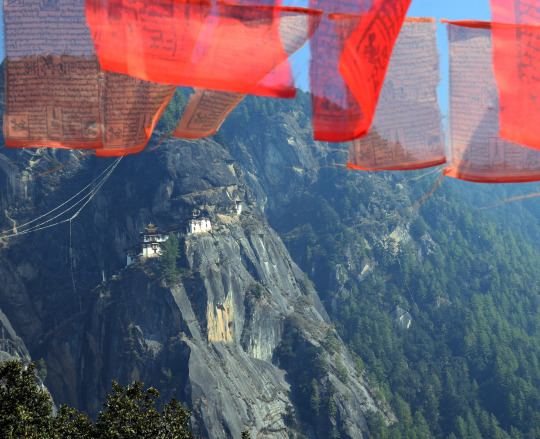
Taktsang monastery on the side of a mountain overlooking Paro Valley in Bhutan. The World Heritage site is featured prominently in the National Geographic book “Sacred Places of a Lifetime,” a showcase of the world’s most powerful and spiritual places. Photograph by David Braun.
PARO, Bhutan–It’s a steep climb to Paro Taktsang, a Himalayan Buddhist monastery hugging the side of a rocky cliff 3,000 feet above the Paro valley in Bhutan. It requires ascending a thousand steps or more, but the path is well constructed and maintained, and the mountain air is fresh and cool. There are plenty of opportunities to stop to admire the spectacular surroundings, making the ascent quite enjoyable if taken slowly.
For those of us who live at sea level it can be difficult to breathe comfortably while exercising vigorously at 10,000 feet, so a relaxed pace with plenty of rest is definitely the way to make this pilgrimage, as advised by our expedition leader, Bill Jones.
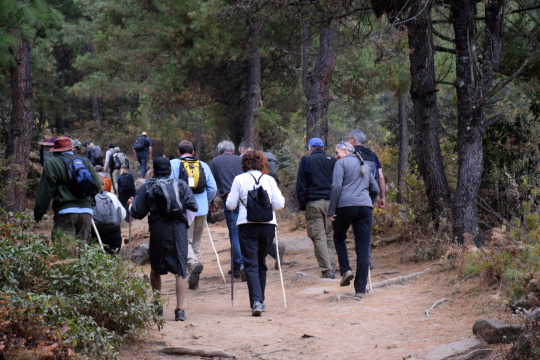
The National Geographic Committee for Research and Exploration at the start of the hike up to Taktsang monastery. Photograph by David Braun.
The pilgrimage to Taktsang, also known as Tiger’s Nest or Tiger’s Lair, is (literally and figuratively) the high point of any visitor’s sojourn in Bhutan. For the National Geographic Committee for Research and Exploration delegation, it was the final stop of a week-long visit that had taken us around the western part of the kingdom, visiting dzongs (monastery fortresses), temples, and the wintering grounds of extremely rare white-bellied herons and black-necked cranes. We’d had plenty of time to acclimate to the altitude and there had been at least two long walks through farms and villages to prepare us for the steep climb to the Tiger’s Nest.
Flying in on a Tigress
Taktsang is said to be the holiest site in Bhutan. It’s where Guru Rinpoche, also known as Padmasambhava, materialized some 1,300 years ago on the back of a flying tigress. Finding shelter in a series of caves, he meditated for some three years and then set about converting the Bhutanese to Buddhism.

Wall painting of Padmasambhava on Paro bridge. Image by by Baldiri, Wikimedia Creative Commons.
The monastery that commemorates this auspicious beginning was built nine centuries later, in the 1600s, although the buildings we see today have been replaced several times, including major reconstruction completed in 2005 after a fire devastated the structure and its contents in 1998.
Ever taking the long view, the Bhutanese point out that buildings are temporal and meant to be renewed; the ideas and philosophies they represent cannot be destroyed.

Photograph by David Braun.
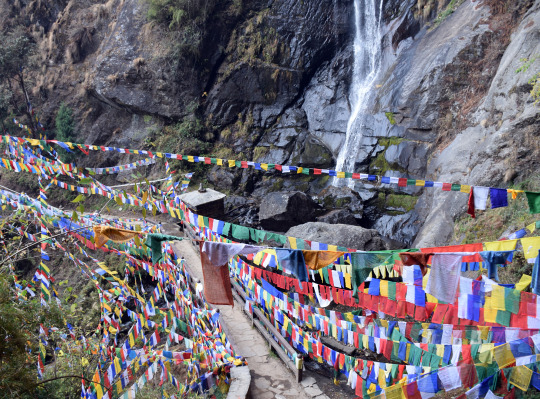
Thousands of prayer flags frame a 200-foot waterfall below the Tiger’s Nest Monastery. Photograph by David Braun.

Small reliquaries or “tsa-tsas” containing ashes of the dead on ledges in the vicinity of Tiger’s Nest. Photograph by David Braun.
The final approach to the monastery after a climb of around two hours is over a bridge across a waterfall that drops 200 feet into a sacred pool. The entire area is wrapped in prayer flags, while crevices in the rock are crammed with tsa-tsas, small reliquaries made from ashes of the dead. One last brutal flight of steep steps hewn out of rock delivers pilgrims to the monastery, which for our visit was blanketed in low-hanging cloud, adding an aura of heaven to the place.
Entry to the sanctuary is granted on condition that shoes, cameras, cell phones and other electronic equipment are left at the gates. A security guard patted us down to make sure we were not smuggling cameras and he instructed us to button our jackets as a mark of respect for the holy place. Inside we were given a tour of various temples and other chambers crammed with Buddhist icons and heaped offerings of food and money. Flickering traditional butter lamps cast a warm ethereal light.
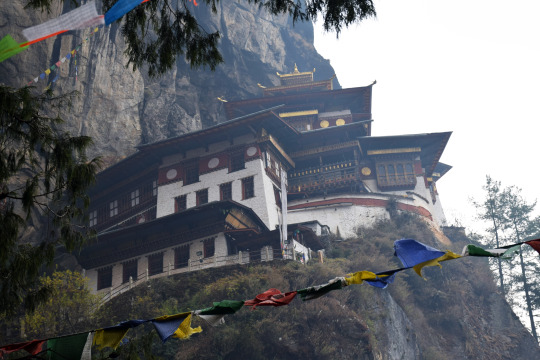
Taktsang’s main structures were rebuilt after a fire all but destroyed the complex 16 years ago. A consortium of international donors restored the site to its former glory in 2005. Photograph by David Braun.
Holy Water
In one temple we encountered a monk watching over a door sealing the cave used by Padmasambhava all those centuries ago. It is opened only once a year in a special ceremony, perhaps like Easter Sunday in the Vatican’s St Peter’s basilica. The monk blessed us and poured saffron-laced water into our hands which we brought to our lips and splashed on the crown of our heads. In the next sanctuary we found a monk chanting sacred texts. He too splashed holy water into our hands for our mouths and heads, and he offered us something to eat.
We were alone in the third room we visited. Our guide stood with us at the door and explained the chamber’s purpose and the iconography on the altar, including a sitting statue of Padmasambhava. Then he invited us to sit quietly on the floor and meditate a while about where we were and what we were seeing and experiencing.
I became conscious of the complete silence of our situation in the clouds thousands of feet up on the side of a mountain deep in the Himalayas.
Cross-legged comfortably on a mat, feet pointed in respectfully, I first thought what a difference it made to be looking at the icons without the encumbrance of a camera. I became conscious of the complete silence of our situation in the clouds thousands of feet up on the side of a mountain deep in the Himalayas.
As I listened to the silence and stared into the fierce eyes of one of the statues my mind shifted abruptly; into my head came the memory of my mother who passed away 34 years ago, and I thought how much she, a Buddhist at heart, would have wanted to visit this remarkable holy shrine. Just then a bird trilled loudly from the ledge of an open window right behind me, and I imagined it was my mother’s way of telling me that she heard me, and that she was with me in this special place.
It is not uncommon for people to have some kind of spiritual experience at Taktsang, Bill Jones, our expedition leader, told me after we had left the monastery. Bill has led groups to Bhutan more than a hundred times, taking perhaps a thousand people up to the shrine. “I can’t tell you how many people have told me that something happened to them spiritually up there,” he said when I told him my story about the bird and thoughts of my mother.
I also learned that the bird that had interrupted my reverie was a rufous-breasted accentor (Prunella strophiata), a common resident throughout the Himalayas. (You can listen to its song here.)
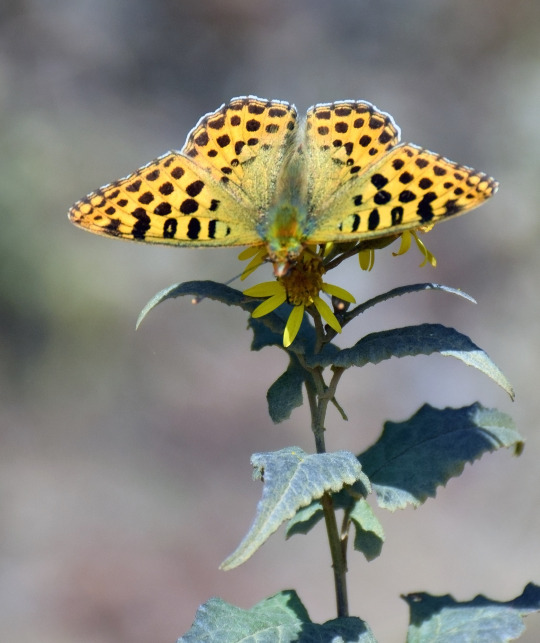
The two-hour stroll up the mountain to Taktsang is through forests of rhododendron and pines, with many birds and smaller animals to be enjoyed. Photograph by David Braun.
Birds are abundant in Bhutan. Everywhere we went we saw crows on houses and monasteries. We learned that schools had been relocated and electricity cables buried to make wetlands safe for the black-necked cranes (Grus nigricollis) that migrate from the Tibetan Plateau, where they breed in the summer.
To make this annual journey, the cranes must fly through extremely harsh conditions over the world’s highest mountains. Residents of Phobjikha say they see the birds circle Gangteng Monastery three times when they arrive at the valley’s marshes for the winter, and three times again when they begin their return. It’s one more spiritual connection between the people and wildlife of Bhutan.
Led by the royal family, the government has committed to protecting Phobjikha Valley for the cranes, and also to keeping more than half of the rest of the country as natural forest. Wildlife corridors have also been set aside for elephants, tigers, leopards, and all the animals smaller than them, to be able to migrate freely between national parks in both Bhutan and neighboring India.
Surrounded entirely by China and India, the two most populous nations on Earth, Bhutan’s isolation and its ancient spirituality have enabled the country to hang on to much of its culture and natural heritage.
But as the country continues to modernize and open to the world, Bhutan will be challenged to stay this way. The teachings brought to Taktsang by Padmasambhava 1,300 years ago include belief in the power and value of nature. Keeping the faith might be what empowers the country to choose the right way forward.
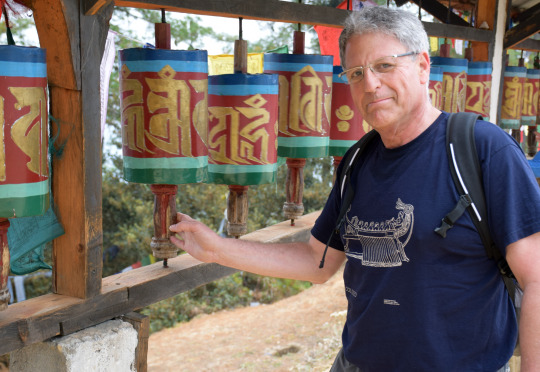
National Geographic President and CEO Gary Knell spins prayer wheels prior to hiking to the Tiger’s Nest monastery. Photograph by David Braun.
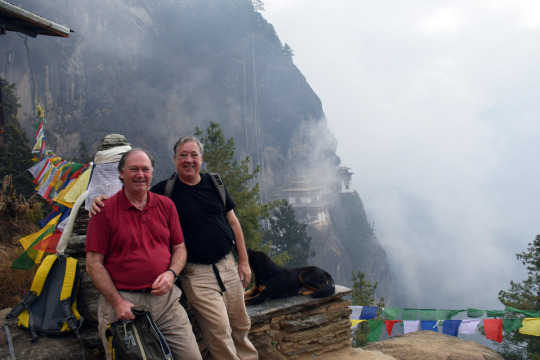
CRE member Keith Clarke (left) and David Braun pause for a photo en route to Tiger’s Nest. We did not know anything about the beautiful dog sitting serenely next to us. Photograph courtesy of David Braun.
National Geographic President and CEO Gary Knell led the Committee for Research and Exploration on a tour of the Himalayan kingdom to meet with grantees, listen to briefings from government officials and environment groups, and observe science, exploration, and conservation in the field. The delegation visited dzongs and other religious places, wildlife sites, and had an audience with King Jigme Khesar Namgyel Wangchuck. The Society has funded nearly two dozen research projects in Bhutan, two of which were active at the time of the National Geographic visit. National Geographic published its first article about Bhutan in 1914: a compelling account of explorations and surveys by John Claude White, a British Raj administrator and an accomplished amateur photographer. Read (and enjoy the 100-year-old photos) here: Castles in the Air: Experiences and Journeys in Unknown Bhutan
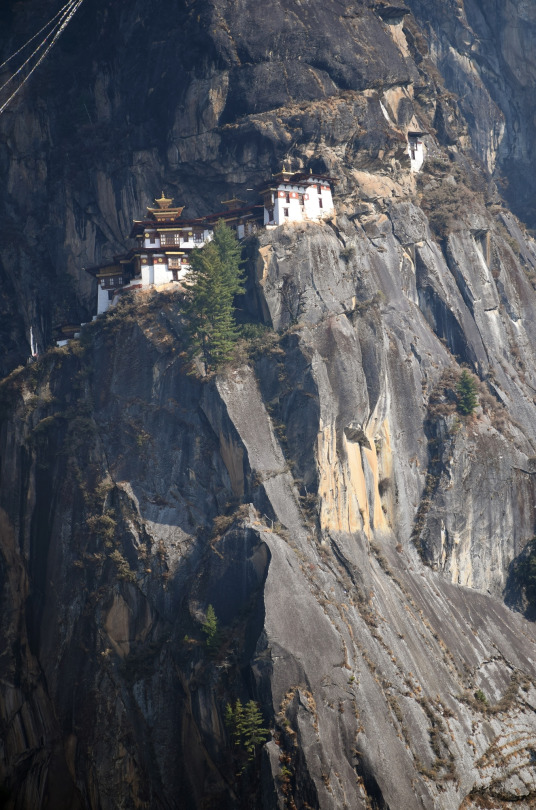
Taktsang is built on a series of ledges on near vertical rock cliffs thousands of feet above Paro. The monastery is some 10,000 feet above sea level. Photograph by David Braun.
#bhutan#taktshang monastery#tiger’s nest#paro#world heritage site#national geographic#guru rinpoche#padmasambhava#buddhism#prayer flags#himalayas#birds
0 notes
Text
Coronavirus Outbreak: How do we mitigate the impact of gray rhino events in the future?— Part 3
The Dutch sea captain Willem de Vlamingh never imagined in his wildest dreams that black swans could exist. He never saw or heard of one in Europe. In January 1697 he and his crew sailed up a river, later named Swan River, in Southwestern Australia to explore it. And much to their utter amazement they became the first Europeans to see black swans.
“Black swan” events are extremely rare and highly improbable events. They share three characteristics:
1) they are unpredictable
2) they have a massive impact
3) post the event, we concoct an explanation that makes it appear less random and more predictable.
Is the COVID-19 outbreak a black swan event?
Here are three reasons why it is not an unpredictable event.
First, there have been more than a dozen serious epidemics, many of them worldwide, in the last 100 years (see Box 5). The Spanish flu and smallpox killed 50 million people each. Eighteen million Indians died of Spanish flu. HIV killed 30 million people. The Asian flu and Hong Kong flu killed at least a million people each. But they have faded quickly from public memory.
Second, a paper is written by four Chinese scientists titled, Bat Coronaviruses in China, published on 2 March 2019, specifically warned, “it is highly likely that future SARS- or MERS-like coronavirus outbreaks will originate from bats, and there is an increased probability that this will occur in China. Two bat origin CoVs caused large-scale epidemics in China over fourteen years, highlighting the risk of a future bat CoV outbreak in this nation. Therefore, the investigation of bat coronaviruses becomes an urgent issue for the detection of early warning signs, which in turn minimizes the impact of such future outbreaks in China.” The Chinese government, which funded this study through its science academies, did not heed the warning it carried.
Third, Tedros Adhanom Ghebreyesus, Director-General of WHO, speaking at the World Government Summit, Dubai on 12 February 2018, warned the world, “A devastating epidemic could start in any country at any time and kill millions of people because we are still not prepared. The world remains vulnerable.” The world heard him but did not listen to him.
COVID-19 is not a black swan event. It is a “gray rhino” event, one that is a highly probable and with a potentially large impact. Gray rhino events can be seen in advance because of their size and the early warning they give. Yet, they are ignored. India has had many big gray rhino events in the past.
Recent Indian gray rhino events
India’s record of handling gray rhino events is poor and leaves doubts about how it will handle the coronavirus outbreak. There have been occasions though when it has rolled up its sleeves and done a particularly good job like in the Machilipatnam cyclone or what Kerala is doing now to control COVID-19.
1984 Bhopal gas tragedy: Union Carbide made Sevin, a carbamate group pesticide, in its Bhopal plant. Soon after the plant went into production, Sevin lost market space to the next generation pesticides and the company slipped into losses. Consequently, safety and environmental management standards in the plant declined.
Between 1981-84, the plant had a series of accidents (see Box 6). This prompted journalist Raj Kumar Keshwani to write three articles lamenting on the plant’s poor safety conditions, and warning Bhopal that it was on the brink of a disaster. A state government minister responded saying, “The Carbide plant is not some small pebble that can be picked up and put elsewhere.”
Forty-two tonnes of Methyl Isocyanate (MIC) leaked on the cold winter night of 2 December 1984, killing about 8,000 persons immediately. Another 17,000 died subsequently of chronic toxic effects.
1999 Ersama cyclone: Odisha is hit by a severe cyclone almost every year, and by a super cyclone once every few years. A super cyclone hit Ersama block in coastal Orissa on 29 October 1999. Three 10-metre high storm surges swept everything in their path for up to 20 km inland, killing about 50,000 persons.
2004 Indian Ocean earthquake and tsunami: Indonesia is frequently rocked by earthquakes and the offshore ones sometimes generate tsunamis. On 26 December 2004, a 9.1 magnitude offshore earthquake near Sumatra, Indonesia generated tsunami waves that rose to 9 m before they hit coasts of 14 countries along the Indian Ocean rim, and wreaked enormous destruction. About 250,000 persons died, including 10,000 on the Tamil Nadu and Andhra Pradesh coasts.
Information failures increase lives lost
Information plays a critical role in minimizing the probability of a gray rhino event from becoming a disaster. Information throughputs have five stages—generation, transmission, interpretation, access, and use. An information failure at any of these stages increase the probability of a hazard hit converting into a disaster.
The 2004 Indian Ocean earthquake and tsunami disaster in India was an information generation failure. India did not install seabed sensors in the Bay of Bengal to detect tsunami pressure waves. It was also an information transmission failure as the Indian government was informed about the tsunami soon after it hit the Andaman Islands (see information timeline), which lie close to Sumatra. It took another two hours before the tsunami hit India’s east coast, which was adequate to evacuate fisherfolk inland. Failure to do that was a criminal act of negligence which cost India 10,000 lives.
Information timeline after tsunami wave was generated off the coast of Sumatra, Indonesia
6.29 am 7.30 am 8.00 am 8.56 am 9.00 am 10.30 am 12.00 noon 5.45 pm Quake strikes Sumatra. India Meteorological Department (IMD) knows about it by 6.40 am, but could not analyse data as its computer developed a snag, Indian Air Force (IAF) Nicobar informs IAF Tambaram, who inform IAF Chief who alerts Defence Min Waves lash Machilipatnam, Chennai, Cuddalore, on India’s southeast coast. Faxes sent to Secretaries of Department of Science & Technology, Home Ministry, Home Minister. Tsunami waves strikes east coasts of India, Sri Lanka. Cabinet Secretary calls Port Blair. Secretary of Ocean Development briefs him. Crisis Manage-ment Group meets.
Indian Navy ships dispatched to Andaman Islands.
The IMD computer being down and not available to analyse the incoming data also made this event an information interpretation failure.
The Bhopal gas tragedy was an information access failure. People in Bhopal were sleeping when a highly toxic MIC gas cloud formed at the Carbide plant and drifted slowly downwind towards JP Nagar, Chola Khenchi slums and areas further south. Being heavier than air, the gas cloud hugged the ground, and remained concentrated as the prevailing low wind speed dispersed it very slowly. People woke up and ran to save themselves. But they ran downwind and remained in the gas cloud, inhaling a large amount of toxic MIC gas.
Had they known that they should move perpendicular to the wind direction, the quickest way to get out of a gas cloud, and cover their nose and mouths with a wet cloth as MIC is soluble in water, many thousands of lives may have been saved, and injury would have been less. Not a single Carbide worker died on the as they were aware that running upwind and away from the gas cloud was the best way to save themselves.
The Ersama cyclone disaster was an information use failure. The National Remote Sensing Agency (NRSA) provided the Odisha government with satellite pictures of the cyclone’s path for 3 days prior to the cyclone making landfall. Yet, the Odisha government did not use this information. If the coastal population had been evacuated, most of the 50,000 people who lost their lives would have lived.
There are other examples of hazard strike events that became disasters due to information failures. One of them is the 7.5 magnitude (on the Richter scale) Bhuj earthquake that occurred on 26 January 2001. Hundreds of buildings collapsed in several cities in Gujarat killing about 25,000 people and causing a financial loss of Rs 25,000-50,000 crores.
Had the buildings been built to Bureau of Indian Standards (ISI) codes for earthquake resistant structures, far fewer people would have died. BIS codes were available for engineered and non-engineered buildings but were not used, making this event an information use failure.
Bhuj is in a Zone 5 (most earthquake prone) seismic region, making it a high-risk area. Damage to Gujarat Housing Board colonies built to ISI standards, was minimal, but Shikhar Towers, Himgiri Apartments, and 170 other buildings in Ahmadabad crashed as they were not built to ISI standards.
In a quake of similar magnitude that shook Seattle soon after the Bhuj quake happened, only 3 persons died as structures in that city conformed to building standards for earthquakes.
Lack of emergency response plans and action increase loss of lives
Six elements that constitute emergency response plans and actions (ERPA)—event prediction, warning, hardware and facilities, risk avoidance action by public, emergency response plan (ERP), and the emergency response actions (ERA)—if in place, minimize loss of life when natural or man-made hazards strike. Each missing element increases the probability of the event converting into a disaster and causing great loss of life. A comparison of two cyclones—the 1990 Machilipatnam cyclone that hit the Andhra coast and the 1999 Ersama cyclone—illustrates this point (see Box 7).
Prior information (event prediction) about a hazardous event—its nature, magnitude, hit location and time, lead time between event prediction and hit—helps save lives. Using satellites, IMD tracked the Machilipatnam and Ersama cyclone for several days before they made landfall, and predicted their intensity, landfall location and time accurately. Event predictions for both these cyclones was good.
An effective warning before a hazard hit must fulfil 6 criteria—it should come in time, reach everyone, be appropriate for the event, be unambiguous about the action people should take, sound credible, and be specific to the risk posed by the impending event. The Machilipatnam warning met all these criteria.
The Ersama cyclone warning met the first 3 criteria—it came in time, reached most people on the coast and was appropriate to the event. But it failed the next 3 criteria as it was ambiguous, lacked credibility and was vague. The warning bundled weather and emergency-action information, creating doubt whether people should use their judgement or follow instructions. The warning for the Ersama cyclone was remarkably like the one for a lower intensity cyclone that hit the Ganjam coast 10 days before the Ersama cyclone occurred. As the Ganjam cyclone did not cause much damage or death, going by the similarity between the Ersama and Ganjam cyclone warnings, people thought that Ersama cyclone would be like the Ganjam one. When in doubt people prefer status quo; they stayed home during the Ersama cyclone and were swept away by its giant waves.
The chances of taking risk-avoidance/ mitigation action are higher when people know the risks they face and the choices they have. People in Machilipatnam were ready to evacuate their villages as they had cyclone emergency drills earlier. People in Ersama were not put through such drills and therefore were less aware of the danger they faced and the action they should take to save themselves.
The infrastructure and hardware that Odisha had was highly inadequate--23 cyclone shelters, a police wireless system that died when the cyclone worked itself into a fury, and no backup communication system. Andhra Pradesh had 1,041 cyclone shelters, a police wireless system that could withstood 250 km/hr windspeeds, and a backup active ham radio network.
Odisha had no emergency response plan (ERP) for cyclones and therefore no emergency response action happened in Ersama. Two lakh persons were kept safe in Machilipatnam by evacuating them.
The consequence—50,000 persons died in the Ersama cyclone, even though it happened 9 years after the Machilipatnam cyclone. Less than 1,000 persons died in the Machilipatnam cyclone.
Information failure and lack of emergency response plans will affect India in COVID-19 pandemic
A critical information failure in the COVID-19 outbreak in India is the lack of information on the total number of cases. This can be acquired through extensive testing and good surveillance. But on both counts, India’s effort falls below the curve. When cases are detected at an early stage, they can be isolated immediately and treated. This minimizes the time they are in contact with the people, thus reducing infection spread. India has an information generation failure in its COVID-19 control programme.
Several elements of the emergency response to the coronavirus outbreak in India have failed either partially or entirely.
Event prediction: India was forewarned of the coronavirus outbreak in general way in the form of knowledge of previous virus outbreaks, WHO DG’s warning that a viral epidemic could happen anytime, and the Chinese paper on the possibility of a coronavirus outbreak. India should have had a viral outbreak response plan but does not seem to have one.
The Indian government would have become aware of the coronavirus outbreak in China by early-January 2020. Though there may have been some confusion about the possibility of human to human transmission till 21 January, this was dispelled by the last week of January when WHO declared a global health emergency.
Warning: India had about eight weeks of warning time to prepare before the case numbers started going up sharply towards end-March. Kerala prepared for a coronavirus outbreak from January, but the rest of India did not.
Risk avoidance action by people: As people’s understanding of the risk that coronavirus poses, and the actions they need to take to stay safe is sketchy, their response has been varied. While most people are willing to live with the lockdown, migrants want to return to their villages. Some resistance was visible in Surat in the second week of April when migrants rioted as they wanted transport to return to their villages. Physical distancing is difficult for slum dwellers, and for many ordinary people it is an alien concept.
Infrastructure and facilities: India’s public health system is weak. Isolation and ICU beds, ventilators, doctors, and nursing staff are less than what is required for a large COVID-19 outbreak.
Emergency response plan: The only visible document is the ‘Containment Plan.’ It was prepared in the first week of April and covers plans only for local transmission. Plans for community transmission and epidemics have either not been prepared yet or are not available in public domain.
Emergency response action: India’s response action can best be described as jerky. The way the lockdown was declared gives the impression that the lack of preparedness and the enormity of the problem may have made the government panic. No thought was given to how migrants would respond to a sudden lockdown announcement, and the beating the economy would take because of the break in the supply chain of almost all goods and services, the loss of income to farmers, unorganized labour and self-employed. The steps after lifting the lockdown do not seem to have been thought through either.
India’s actions give the impression that it is playing it by the ear and “muddling through,” which is not the best way to handle a health emergency. But India is not alone in doing this. It has the US, GB and many other countries keeping it company.
Box 5: Pandemics in the last century
Date Deaths Event Disease Location
Jumped into humans from:
1877–1977 500 M Smallpox Worldwide 1899–1923 >800 K Sixth cholera pandemic Cholera Europe, Asia, Africa 1910–12 40 K 1910 China plague Bubonic plague China 1915–26 1.5 M 1915 Encephalitis lethargica pandemic Encephalitis lethargica Worldwide 1918–20 50-100 M Spanish flu Influenza A virus subtype H1N1 Worldwide Pigs 1957–58 2 M Asian flu Influenza A virus subtype H2N2 Worldwide 1968–69 1 M Hong Kong flu Influenza A virus subtype H3N2 Worldwide 1974 15 K 1974 smallpox epidemic of India Smallpox India 1981–present >32 M HIV/AIDS pandemic HIV/AIDS Worldwide Chimpanzees 1998-2018 350-500 Nipah virus infection Nipah Malaysia, Southeast Asia, Kerala (India) Bats 2002-04 774 Severe Acute Respiratory Syndrome (SARS) SARS-CoV-1 China, Hong Kong, Singapore, Worldwide Bats, Civet cat 2009-10 150-575 K Swine influenza virus (SIV) Swine flu Worldwide Pigs 2012-17 666 Middle East Respiratory Syndrome (MERS) Camel flu Saudi Arabia, South Korea, UAE, Worldwide Bats, Camels 1976-2019 1,590 Ebola outbreak Ebola Sudan, Zaire, Guinea, DR Congo, West Africa Bats 2019-present 80 K on 8 Apr 2020 Coronavirus outbreak COVID-19/ SARS-CoV-2 Worldwide
Bats, Pangolin, or another small mammal
Box 6: Series of accidents in the Union Carbide plant, Bhopal, 1981-84
In 1981, a worker was splashed with phosgene. He ripped off his mask in panic, inhaling a large amount of phosgene gas. He died 72 hours later.
In January 1982, 24 workers exposed to phosgene were hospitalized. None of the workers had been ordered to wear protective masks.
In February 1982, an MIC leak affected 18 workers.
In August 1982, an engineer came into contact with liquid MIC, resulting in 30% body burns.
In October 1982, there was a leak of MIC, methyl carbaryl chloride, chloroform, and hydrochloric acid. In attempting to stop the leak, the MIC supervisor suffered intensive chemical burns and two other workers were severely exposed to the gases.
During 1983 and 1984, leaks of the following substances regularly took place in the MIC plant: MIC, chlorine, monomethylamine, phosgene, and carbon tetrachloride, sometimes in combination.
Reports issued by scientists within the Union Carbide Corporation months before the Dec.2 incident warned of the possibility of an accident almost identical to that which occurred in 1984. The reports were ignored and never reached senior staff.
Union Carbide was warned by American experts who visited the plant after 1981 of the potential of a "runaway reaction” in the MIC storage tank; local Indian authorities warned the company of problems on several occasions from 1979 onwards. Again, these warnings were not heeded.
Box 7: How Emergency Planning and Response Actions save lives
Six factors minimize loss of life during hazard strikes. The Ersama cyclone’s high death toll was because of four factors, and a part of the fifth, were out of place.
Elements of emergency response plan Ersama (1999) Machilipatnam (1990) COVID-19 (2019) 1. Event prediction Nature of expected event Yes Yes Yes Event magnitude Yes Yes Yes Event location Yes Yes No Hit time Yes Yes Difficult to predict Lead time 75 hrs Adequate 1 year 2. Warning In time Yes Yes
India had 10-12 weeks warning time
Reach everyone Yes Yes Yes, reached government Appropriate to event Yes Yes Yes to government Unambiguous No Yes
Initial confusion in WHO’s warning
Credible No Yes
Loss of credibility due to initial confusion
Specific to event No Yes Yes 3. Risk avoidance action People confused People willing to act
People willing to act, some reaction visible
4. Infrastructure
India’s public health system poor
Cyclone shelters 23 1041 Wireless No No Ham radios No Yes 5. Emergency response plan No Yes
‘Containment plan’ is available in public domain. Not known if other ERPs exist
Vulnerable zones mapped Yes Yes Vulnerable structures mapped Yes No Emergency response organization No Yes
NDRF exists, but not trained for epidemics
Emergency response codes No No
Triggers for lockdowns not prepared
Emergency response action plan No Yes 6. Emergency response action No 2 lakh people
Government’s actions jerky, playing by ear
Deaths 50,000 <1.000
The author is an environmental engineer with specialization in risk analysis
Also Read:
Coping with the lockdown but is India prepared for an outbreak? — Part 2
Is the COVID-19 pandemic a black swan or a gray rhino event? — Part 1
via Blogger https://ift.tt/2Y2DRH7
0 notes
Quote
The Dutch sea captain Willem de Vlamingh never imagined in his wildest dreams that black swans could exist. He never saw or heard of one in Europe. In January 1697 he and his crew sailed up a river, later named Swan River, in Southwestern Australia to explore it. And much to their utter amazement they became the first Europeans to see black swans. “Black swan” events are extremely rare and highly improbable events. They share three characteristics: 1) they are unpredictable 2) they have a massive impact 3) post the event, we concoct an explanation that makes it appear less random and more predictable. Is the COVID-19 outbreak a black swan event? Here are three reasons why it is not an unpredictable event. First, there have been more than a dozen serious epidemics, many of them worldwide, in the last 100 years (see Box 5). The Spanish flu and smallpox killed 50 million people each. Eighteen million Indians died of Spanish flu. HIV killed 30 million people. The Asian flu and Hong Kong flu killed at least a million people each. But they have faded quickly from public memory. Second, a paper is written by four Chinese scientists titled, Bat Coronaviruses in China, published on 2 March 2019, specifically warned, “it is highly likely that future SARS- or MERS-like coronavirus outbreaks will originate from bats, and there is an increased probability that this will occur in China. Two bat origin CoVs caused large-scale epidemics in China over fourteen years, highlighting the risk of a future bat CoV outbreak in this nation. Therefore, the investigation of bat coronaviruses becomes an urgent issue for the detection of early warning signs, which in turn minimizes the impact of such future outbreaks in China.” The Chinese government, which funded this study through its science academies, did not heed the warning it carried. Third, Tedros Adhanom Ghebreyesus, Director-General of WHO, speaking at the World Government Summit, Dubai on 12 February 2018, warned the world, “A devastating epidemic could start in any country at any time and kill millions of people because we are still not prepared. The world remains vulnerable.” The world heard him but did not listen to him. COVID-19 is not a black swan event. It is a “gray rhino” event, one that is a highly probable and with a potentially large impact. Gray rhino events can be seen in advance because of their size and the early warning they give. Yet, they are ignored. India has had many big gray rhino events in the past. Recent Indian gray rhino events India’s record of handling gray rhino events is poor and leaves doubts about how it will handle the coronavirus outbreak. There have been occasions though when it has rolled up its sleeves and done a particularly good job like in the Machilipatnam cyclone or what Kerala is doing now to control COVID-19. 1984 Bhopal gas tragedy: Union Carbide made Sevin, a carbamate group pesticide, in its Bhopal plant. Soon after the plant went into production, Sevin lost market space to the next generation pesticides and the company slipped into losses. Consequently, safety and environmental management standards in the plant declined. Between 1981-84, the plant had a series of accidents (see Box 6). This prompted journalist Raj Kumar Keshwani to write three articles lamenting on the plant’s poor safety conditions, and warning Bhopal that it was on the brink of a disaster. A state government minister responded saying, “The Carbide plant is not some small pebble that can be picked up and put elsewhere.” Forty-two tonnes of Methyl Isocyanate (MIC) leaked on the cold winter night of 2 December 1984, killing about 8,000 persons immediately. Another 17,000 died subsequently of chronic toxic effects. 1999 Ersama cyclone: Odisha is hit by a severe cyclone almost every year, and by a super cyclone once every few years. A super cyclone hit Ersama block in coastal Orissa on 29 October 1999. Three 10-metre high storm surges swept everything in their path for up to 20 km inland, killing about 50,000 persons. 2004 Indian Ocean earthquake and tsunami: Indonesia is frequently rocked by earthquakes and the offshore ones sometimes generate tsunamis. On 26 December 2004, a 9.1 magnitude offshore earthquake near Sumatra, Indonesia generated tsunami waves that rose to 9 m before they hit coasts of 14 countries along the Indian Ocean rim, and wreaked enormous destruction. About 250,000 persons died, including 10,000 on the Tamil Nadu and Andhra Pradesh coasts. Information failures increase lives lost Information plays a critical role in minimizing the probability of a gray rhino event from becoming a disaster. Information throughputs have five stages—generation, transmission, interpretation, access, and use. An information failure at any of these stages increase the probability of a hazard hit converting into a disaster. The 2004 Indian Ocean earthquake and tsunami disaster in India was an information generation failure. India did not install seabed sensors in the Bay of Bengal to detect tsunami pressure waves. It was also an information transmission failure as the Indian government was informed about the tsunami soon after it hit the Andaman Islands (see information timeline), which lie close to Sumatra. It took another two hours before the tsunami hit India’s east coast, which was adequate to evacuate fisherfolk inland. Failure to do that was a criminal act of negligence which cost India 10,000 lives. Information timeline after tsunami wave was generated off the coast of Sumatra, Indonesia 6.29 am 7.30 am 8.00 am 8.56 am 9.00 am 10.30 am 12.00 noon 5.45 pm Quake strikes Sumatra. India Meteorological Department (IMD) knows about it by 6.40 am, but could not analyse data as its computer developed a snag, Indian Air Force (IAF) Nicobar informs IAF Tambaram, who inform IAF Chief who alerts Defence Min Waves lash Machilipatnam, Chennai, Cuddalore, on India’s southeast coast. Faxes sent to Secretaries of Department of Science & Technology, Home Ministry, Home Minister. Tsunami waves strikes east coasts of India, Sri Lanka. Cabinet Secretary calls Port Blair. Secretary of Ocean Development briefs him. Crisis Manage-ment Group meets. Indian Navy ships dispatched to Andaman Islands. The IMD computer being down and not available to analyse the incoming data also made this event an information interpretation failure. The Bhopal gas tragedy was an information access failure. People in Bhopal were sleeping when a highly toxic MIC gas cloud formed at the Carbide plant and drifted slowly downwind towards JP Nagar, Chola Khenchi slums and areas further south. Being heavier than air, the gas cloud hugged the ground, and remained concentrated as the prevailing low wind speed dispersed it very slowly. People woke up and ran to save themselves. But they ran downwind and remained in the gas cloud, inhaling a large amount of toxic MIC gas. Had they known that they should move perpendicular to the wind direction, the quickest way to get out of a gas cloud, and cover their nose and mouths with a wet cloth as MIC is soluble in water, many thousands of lives may have been saved, and injury would have been less. Not a single Carbide worker died on the as they were aware that running upwind and away from the gas cloud was the best way to save themselves. The Ersama cyclone disaster was an information use failure. The National Remote Sensing Agency (NRSA) provided the Odisha government with satellite pictures of the cyclone’s path for 3 days prior to the cyclone making landfall. Yet, the Odisha government did not use this information. If the coastal population had been evacuated, most of the 50,000 people who lost their lives would have lived. There are other examples of hazard strike events that became disasters due to information failures. One of them is the 7.5 magnitude (on the Richter scale) Bhuj earthquake that occurred on 26 January 2001. Hundreds of buildings collapsed in several cities in Gujarat killing about 25,000 people and causing a financial loss of Rs 25,000-50,000 crores. Had the buildings been built to Bureau of Indian Standards (ISI) codes for earthquake resistant structures, far fewer people would have died. BIS codes were available for engineered and non-engineered buildings but were not used, making this event an information use failure. Bhuj is in a Zone 5 (most earthquake prone) seismic region, making it a high-risk area. Damage to Gujarat Housing Board colonies built to ISI standards, was minimal, but Shikhar Towers, Himgiri Apartments, and 170 other buildings in Ahmadabad crashed as they were not built to ISI standards. In a quake of similar magnitude that shook Seattle soon after the Bhuj quake happened, only 3 persons died as structures in that city conformed to building standards for earthquakes. Lack of emergency response plans and action increase loss of lives Six elements that constitute emergency response plans and actions (ERPA)—event prediction, warning, hardware and facilities, risk avoidance action by public, emergency response plan (ERP), and the emergency response actions (ERA)—if in place, minimize loss of life when natural or man-made hazards strike. Each missing element increases the probability of the event converting into a disaster and causing great loss of life. A comparison of two cyclones—the 1990 Machilipatnam cyclone that hit the Andhra coast and the 1999 Ersama cyclone—illustrates this point (see Box 7). Prior information (event prediction) about a hazardous event—its nature, magnitude, hit location and time, lead time between event prediction and hit—helps save lives. Using satellites, IMD tracked the Machilipatnam and Ersama cyclone for several days before they made landfall, and predicted their intensity, landfall location and time accurately. Event predictions for both these cyclones was good. An effective warning before a hazard hit must fulfil 6 criteria—it should come in time, reach everyone, be appropriate for the event, be unambiguous about the action people should take, sound credible, and be specific to the risk posed by the impending event. The Machilipatnam warning met all these criteria. The Ersama cyclone warning met the first 3 criteria—it came in time, reached most people on the coast and was appropriate to the event. But it failed the next 3 criteria as it was ambiguous, lacked credibility and was vague. The warning bundled weather and emergency-action information, creating doubt whether people should use their judgement or follow instructions. The warning for the Ersama cyclone was remarkably like the one for a lower intensity cyclone that hit the Ganjam coast 10 days before the Ersama cyclone occurred. As the Ganjam cyclone did not cause much damage or death, going by the similarity between the Ersama and Ganjam cyclone warnings, people thought that Ersama cyclone would be like the Ganjam one. When in doubt people prefer status quo; they stayed home during the Ersama cyclone and were swept away by its giant waves. The chances of taking risk-avoidance/ mitigation action are higher when people know the risks they face and the choices they have. People in Machilipatnam were ready to evacuate their villages as they had cyclone emergency drills earlier. People in Ersama were not put through such drills and therefore were less aware of the danger they faced and the action they should take to save themselves. The infrastructure and hardware that Odisha had was highly inadequate--23 cyclone shelters, a police wireless system that died when the cyclone worked itself into a fury, and no backup communication system. Andhra Pradesh had 1,041 cyclone shelters, a police wireless system that could withstood 250 km/hr windspeeds, and a backup active ham radio network. Odisha had no emergency response plan (ERP) for cyclones and therefore no emergency response action happened in Ersama. Two lakh persons were kept safe in Machilipatnam by evacuating them. The consequence—50,000 persons died in the Ersama cyclone, even though it happened 9 years after the Machilipatnam cyclone. Less than 1,000 persons died in the Machilipatnam cyclone. Information failure and lack of emergency response plans will affect India in COVID-19 pandemic A critical information failure in the COVID-19 outbreak in India is the lack of information on the total number of cases. This can be acquired through extensive testing and good surveillance. But on both counts, India’s effort falls below the curve. When cases are detected at an early stage, they can be isolated immediately and treated. This minimizes the time they are in contact with the people, thus reducing infection spread. India has an information generation failure in its COVID-19 control programme. Several elements of the emergency response to the coronavirus outbreak in India have failed either partially or entirely. Event prediction: India was forewarned of the coronavirus outbreak in general way in the form of knowledge of previous virus outbreaks, WHO DG’s warning that a viral epidemic could happen anytime, and the Chinese paper on the possibility of a coronavirus outbreak. India should have had a viral outbreak response plan but does not seem to have one. The Indian government would have become aware of the coronavirus outbreak in China by early-January 2020. Though there may have been some confusion about the possibility of human to human transmission till 21 January, this was dispelled by the last week of January when WHO declared a global health emergency. Warning: India had about eight weeks of warning time to prepare before the case numbers started going up sharply towards end-March. Kerala prepared for a coronavirus outbreak from January, but the rest of India did not. Risk avoidance action by people: As people’s understanding of the risk that coronavirus poses, and the actions they need to take to stay safe is sketchy, their response has been varied. While most people are willing to live with the lockdown, migrants want to return to their villages. Some resistance was visible in Surat in the second week of April when migrants rioted as they wanted transport to return to their villages. Physical distancing is difficult for slum dwellers, and for many ordinary people it is an alien concept. Infrastructure and facilities: India’s public health system is weak. Isolation and ICU beds, ventilators, doctors, and nursing staff are less than what is required for a large COVID-19 outbreak. Emergency response plan: The only visible document is the ‘Containment Plan.’ It was prepared in the first week of April and covers plans only for local transmission. Plans for community transmission and epidemics have either not been prepared yet or are not available in public domain. Emergency response action: India’s response action can best be described as jerky. The way the lockdown was declared gives the impression that the lack of preparedness and the enormity of the problem may have made the government panic. No thought was given to how migrants would respond to a sudden lockdown announcement, and the beating the economy would take because of the break in the supply chain of almost all goods and services, the loss of income to farmers, unorganized labour and self-employed. The steps after lifting the lockdown do not seem to have been thought through either. India’s actions give the impression that it is playing it by the ear and “muddling through,” which is not the best way to handle a health emergency. But India is not alone in doing this. It has the US, GB and many other countries keeping it company. Box 5: Pandemics in the last century Date Deaths Event Disease Location Jumped into humans from: 1877–1977 500 M Smallpox Worldwide 1899–1923 800 K"}" data-sheets-numberformat="{"1":2,"2":"#,##0","3":1}">>800 K Sixth cholera pandemic Cholera Europe, Asia, Africa 1910–12 40 K 1910 China plague Bubonic plague China 1915–26 1.5 M 1915 Encephalitis lethargica pandemic Encephalitis lethargica Worldwide 1918–20 50-100 M Spanish flu Influenza A virus subtype H1N1 Worldwide Pigs 1957–58 2 M Asian flu Influenza A virus subtype H2N2 Worldwide 1968–69 1 M Hong Kong flu Influenza A virus subtype H3N2 Worldwide 1974 15 K 1974 smallpox epidemic of India Smallpox India 1981–present 32 M"}">>32 M HIV/AIDS pandemic HIV/AIDS Worldwide Chimpanzees 1998-2018 350-500 Nipah virus infection Nipah Malaysia, Southeast Asia, Kerala (India) Bats 2002-04 774 Severe Acute Respiratory Syndrome (SARS) SARS-CoV-1 China, Hong Kong, Singapore, Worldwide Bats, Civet cat 2009-10 150-575 K Swine influenza virus (SIV) Swine flu Worldwide Pigs 2012-17 666 Middle East Respiratory Syndrome (MERS) Camel flu Saudi Arabia, South Korea, UAE, Worldwide Bats, Camels 1976-2019 1,590 Ebola outbreak Ebola Sudan, Zaire, Guinea, DR Congo, West Africa Bats 2019-present 80 K on 8 Apr 2020 Coronavirus outbreak COVID-19/ SARS-CoV-2 Worldwide Bats, Pangolin, or another small mammal Box 6: Series of accidents in the Union Carbide plant, Bhopal, 1981-84 In 1981, a worker was splashed with phosgene. He ripped off his mask in panic, inhaling a large amount of phosgene gas. He died 72 hours later. In January 1982, 24 workers exposed to phosgene were hospitalized. None of the workers had been ordered to wear protective masks. In February 1982, an MIC leak affected 18 workers. In August 1982, an engineer came into contact with liquid MIC, resulting in 30% body burns. In October 1982, there was a leak of MIC, methyl carbaryl chloride, chloroform, and hydrochloric acid. In attempting to stop the leak, the MIC supervisor suffered intensive chemical burns and two other workers were severely exposed to the gases. During 1983 and 1984, leaks of the following substances regularly took place in the MIC plant: MIC, chlorine, monomethylamine, phosgene, and carbon tetrachloride, sometimes in combination. Reports issued by scientists within the Union Carbide Corporation months before the Dec.2 incident warned of the possibility of an accident almost identical to that which occurred in 1984. The reports were ignored and never reached senior staff. Union Carbide was warned by American experts who visited the plant after 1981 of the potential of a "runaway reaction” in the MIC storage tank; local Indian authorities warned the company of problems on several occasions from 1979 onwards. Again, these warnings were not heeded. Box 7: How Emergency Planning and Response Actions save lives Six factors minimize loss of life during hazard strikes. The Ersama cyclone’s high death toll was because of four factors, and a part of the fifth, were out of place. Elements of emergency response plan Ersama (1999) Machilipatnam (1990) COVID-19 (2019) 1. Event prediction Nature of expected event Yes Yes Yes Event magnitude Yes Yes Yes Event location Yes Yes No Hit time Yes Yes Difficult to predict Lead time 75 hrs Adequate 1 year 2. Warning In time Yes Yes India had 10-12 weeks warning time Reach everyone Yes Yes Yes, reached government Appropriate to event Yes Yes Yes to government Unambiguous No Yes Initial confusion in WHO’s warning Credible No Yes Loss of credibility due to initial confusion Specific to event No Yes Yes 3. Risk avoidance action People confused People willing to act People willing to act, some reaction visible 4. Infrastructure India’s public health system poor Cyclone shelters 23 1041 Wireless No No Ham radios No Yes 5. Emergency response plan No Yes ‘Containment plan’ is available in public domain. Not known if other ERPs exist Vulnerable zones mapped Yes Yes Vulnerable structures mapped Yes No Emergency response organization No Yes NDRF exists, but not trained for epidemics Emergency response codes No No Triggers for lockdowns not prepared Emergency response action plan No Yes 6. Emergency response action No 2 lakh people Government’s actions jerky, playing by ear Deaths 50,000
http://sansaartimes.blogspot.com/2020/04/coronavirus-outbreak-how-do-we-mitigate.html
0 notes